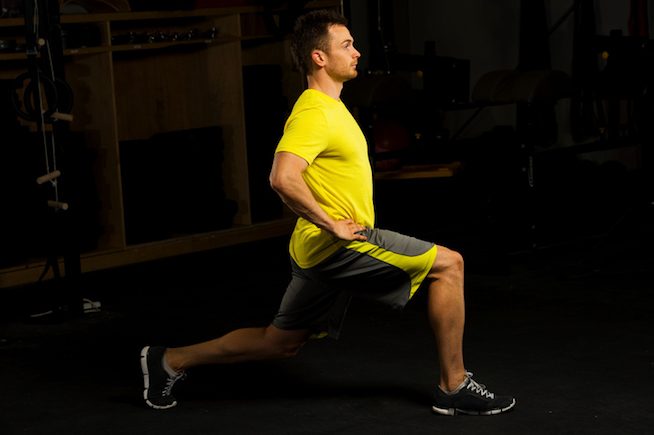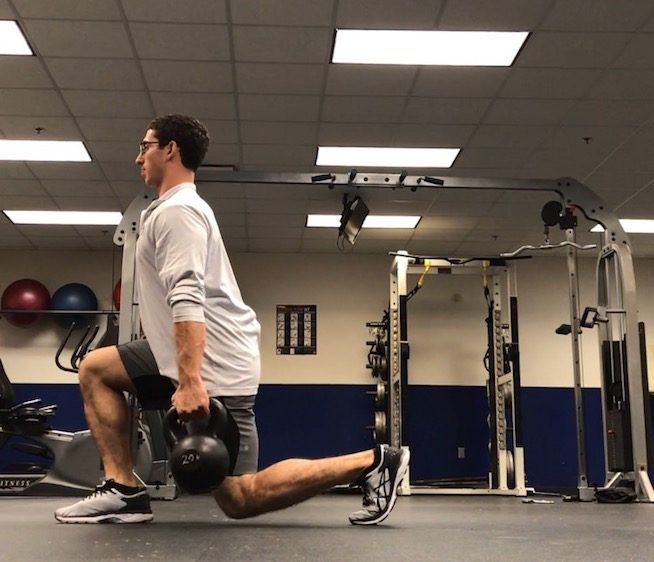How to Perform Walking Lunges Correctly
Walking Lunges are often the first—and sometimes only—type of Lunge that athletes try. Why? The exercise is one of the most basic single-leg moves to build single-leg strength with a focus on the quads and glutes.
However, I encourage you to think of Walking Lunges a little differently. In a recent discussion with Dr. Joel Seedman, strength coach, owner of Advanced Human Performance and one of the top innovators in the strength and conditioning field, he discussed how the Walking Lunge is actually the most advanced type of Lunge because you have to execute perfect technique while moving.
This caused me to rethink how I use Walking Lunges and I believe this approach could help you get the most out of this common exercise. But first, you need to know how to actually perform the move.
Walking Lunge Form
Step 1: Stand with your feet hip-width apart with your core tight and back flat.
Step 2: Lean forward slightly and take a step forward with your right leg (more on this below). Stay up on your back toes. The inside of your front foot should be aligned with the inside of your back foot.
Step 3: Bend your right knee and drop your left knee toward the ground to lower into the Lunge until your thigh is nearly parallel to the ground. Your left knee should be just above the ground, and your right knee should be directly over your ankle or just in front of it. Make sure to avoid arching through your lower back.
Step 4: Drive through your right foot to stand up out of the Lunge. If you have sufficient balance, swing your left leg through to perform the next rep, but it’s OK to reset if needed.
How to find the perfect Lunge step length
Many athletes make the mistake of taking a step that’s far too long, which turns the Lunge into a hip flexor stretch and may cause your back to arch. On the flip side, a lunge step that’s too short will cause your front knee to shoot forward.

There are two mistakes here: 1) His step is far too long, which turns this into a hip flexor stretch; and 2) He has a lower-back arch before even lowering into the Lunge.
The ideal lunge stance allows your body to easily move vertically. Your torso and hips move straight down, your front shin and rear thigh are close to vertical. The easiest way to find the ideal step length for your body is to test it out and film yourself, and practice with Split Squats so your body can learn how a lunge movement should feel.
How to Use Walking Lunges
Before trying Walking Lunges, you need to master the Split Squat and Forward Lunge. The Split Squat keeps you in one steady position, while the Forward Lunge begins to incorporate movement. Walking Lunge progresses to continuous motion from one leg to the next requiring great balance and stability.
The Walking Lunge is not an exercise that trains absolute strength as it makes absolutely no sense to train it heavy for less than five steps. Instead, it is used for strength endurance, hypertrophy, balance, stability and coordination.
This means a range of 3-5 sets for a minimum of 6 steps on each leg and maximum of 12 steps. Higher repetition sets lead to both hypertrophy and strength endurance, and make balance more and more challenging with each step for a Lunge. Hammering the hypertrophy, strength endurance, balance and coordination aspect with longer sets really helps develop athletes, as these are crucial facets that must be sustained throughout their specific sporting event.
It is best as an athlete to use this earlier in the offseason when soreness does not hamper immediate performance on the field, and avoid it as much as possible throughout the season. This is something emphasized by Eric Cressey, strength coach for some of the top baseball players in the country. For general population, it does not matter as much when they are performed so long as they are done during a higher repetition range program, which promotes hypertrophy and strength endurance.
The Best Walking Lunge Variations
Variations including the 2 Kettlebell Walking Lunge, 2 Kettlebell Racked Walking Lunge and 2 Kettlebell Overhead Walking Lunge are three of my favorite variations. These exercises are shown in the video above. To further increase the balance and stability challenge of these exercises, use them in their one kettlebell versions. Using only one kettlebell provides both unilateral and contralateral movement as it remains on one side of the body in a specific arm while both legs still travel continuously. How advanced the lifter is can help determine which variation is used in terms of kettlebell placement.
READ MORE:
[cf]skyword_tracking_tag[/cf]RECOMMENDED FOR YOU
MOST POPULAR
How to Perform Walking Lunges Correctly
Walking Lunges are often the first—and sometimes only—type of Lunge that athletes try. Why? The exercise is one of the most basic single-leg moves to build single-leg strength with a focus on the quads and glutes.
However, I encourage you to think of Walking Lunges a little differently. In a recent discussion with Dr. Joel Seedman, strength coach, owner of Advanced Human Performance and one of the top innovators in the strength and conditioning field, he discussed how the Walking Lunge is actually the most advanced type of Lunge because you have to execute perfect technique while moving.
This caused me to rethink how I use Walking Lunges and I believe this approach could help you get the most out of this common exercise. But first, you need to know how to actually perform the move.
Walking Lunge Form
Step 1: Stand with your feet hip-width apart with your core tight and back flat.
Step 2: Lean forward slightly and take a step forward with your right leg (more on this below). Stay up on your back toes. The inside of your front foot should be aligned with the inside of your back foot.
Step 3: Bend your right knee and drop your left knee toward the ground to lower into the Lunge until your thigh is nearly parallel to the ground. Your left knee should be just above the ground, and your right knee should be directly over your ankle or just in front of it. Make sure to avoid arching through your lower back.
Step 4: Drive through your right foot to stand up out of the Lunge. If you have sufficient balance, swing your left leg through to perform the next rep, but it’s OK to reset if needed.
How to find the perfect Lunge step length
Many athletes make the mistake of taking a step that’s far too long, which turns the Lunge into a hip flexor stretch and may cause your back to arch. On the flip side, a lunge step that’s too short will cause your front knee to shoot forward.

There are two mistakes here: 1) His step is far too long, which turns this into a hip flexor stretch; and 2) He has a lower-back arch before even lowering into the Lunge.
The ideal lunge stance allows your body to easily move vertically. Your torso and hips move straight down, your front shin and rear thigh are close to vertical. The easiest way to find the ideal step length for your body is to test it out and film yourself, and practice with Split Squats so your body can learn how a lunge movement should feel.
How to Use Walking Lunges
Before trying Walking Lunges, you need to master the Split Squat and Forward Lunge. The Split Squat keeps you in one steady position, while the Forward Lunge begins to incorporate movement. Walking Lunge progresses to continuous motion from one leg to the next requiring great balance and stability.
The Walking Lunge is not an exercise that trains absolute strength as it makes absolutely no sense to train it heavy for less than five steps. Instead, it is used for strength endurance, hypertrophy, balance, stability and coordination.
This means a range of 3-5 sets for a minimum of 6 steps on each leg and maximum of 12 steps. Higher repetition sets lead to both hypertrophy and strength endurance, and make balance more and more challenging with each step for a Lunge. Hammering the hypertrophy, strength endurance, balance and coordination aspect with longer sets really helps develop athletes, as these are crucial facets that must be sustained throughout their specific sporting event.
It is best as an athlete to use this earlier in the offseason when soreness does not hamper immediate performance on the field, and avoid it as much as possible throughout the season. This is something emphasized by Eric Cressey, strength coach for some of the top baseball players in the country. For general population, it does not matter as much when they are performed so long as they are done during a higher repetition range program, which promotes hypertrophy and strength endurance.
The Best Walking Lunge Variations
Variations including the 2 Kettlebell Walking Lunge, 2 Kettlebell Racked Walking Lunge and 2 Kettlebell Overhead Walking Lunge are three of my favorite variations. These exercises are shown in the video above. To further increase the balance and stability challenge of these exercises, use them in their one kettlebell versions. Using only one kettlebell provides both unilateral and contralateral movement as it remains on one side of the body in a specific arm while both legs still travel continuously. How advanced the lifter is can help determine which variation is used in terms of kettlebell placement.
READ MORE:
[cf]skyword_tracking_tag[/cf]











